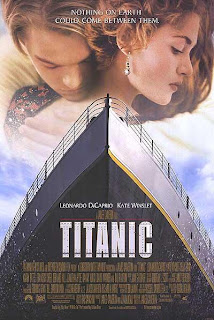
In our lesson we learnt about denotation and connotation. Denotation is simply what is shown in an image, while connotation is the meaning behind the image. The advert denotes a man hugging a woman. The man is dressed simply while the woman is dressed in elegant, expensive clothes and has a diamond earring. Both their faces are sombre and the woman is looking downwards. You can also see the front of a ship taken from a low angle with water splashing at its sides. The title Titanic is written in big capital letters in front of the ship, while all the other text is written in much smaller letters. The heading at the top of the advert says ‘Nothing on earth could come between them’.
The connotation of the two people hugging is that they are in a loving relationship together. The words ‘Nothing on earth could come between them’ also suggest that the two people are deeply in love. This phrase could also mean that since nothing on earth can come between them, but the Titanic is on the sea, it will be the sea that comes between them. The man is dressed simply, which could mean that he’s quite poor, while the classily dressed woman looks a lot richer. The fact that this is quite obvious could mean that their wealth could be an important factor in this film. The diamond earring stands out, also suggesting that some kind of diamond plays a part in the story. The ship in the foreground shows that the ship is central in this story. This is also clear by the fact that the film is named after it, and it could suggest that the setting of the film is on the Titanic.
 The Colour Replacement Tool is then selected and the colour is set to black. Then the selected areas can be filled in.
The Colour Replacement Tool is then selected and the colour is set to black. Then the selected areas can be filled in.











